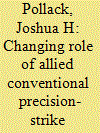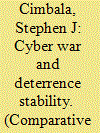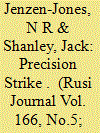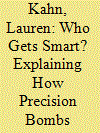| Srl | Item |
| 1 |
ID:
182636


|
|
|
|
|
| Summary/Abstract |
Multiple non-nuclear-armed states in alliances with nuclear-armed states are in the process of acquiring long-range, conventionally armed precision-strike weapons, some of which have potential to contribute to attacks on enemy nuclear forces. This change in the distribution of advanced military technologies has the unintended consequence of giving these non-nuclear-armed states an active role in strategic stability. We provide a theoretical framework for understanding the newly emerging pathways to nuclear use that result. We also investigate perceptions of the role of precision-strike capabilities in six non-nuclear-armed states at various stages in the process of developing these capabilities.
|
|
|
|
|
|
|
|
|
|
|
|
|
|
|
|
| 2 |
ID:
133995


|
|
|
|
|
| Publication |
2014.
|
| Summary/Abstract |
Nuclear deterrence and cyber war are often discussed as separate worlds of research and military-strategic practice. To the contrary, a certain degree of overlap between nuclear deterrence and cyber conflicts is a plausible expectation for several reasons. First, future deterrent challenges will include regional nuclear arms races accompanied by competition in information technology and other aspects of advanced conventional command-control and precision strike systems. Second, cyber-attacks may be used against opposed nuclear command-control systems and weapons platforms as well as against infrastructure for the purpose of mass disruption during a crisis or war. Third, cyber capabilities support escalation dominance or escalation control, depending on the objectives of states and on the transparency of identification for cyber friends and foes.
|
|
|
|
|
|
|
|
|
|
|
|
|
|
|
|
| 3 |
ID:
184614


|
|
|
|
|
| Summary/Abstract |
This article examines the development of precision guided munitions (PGMs) from the earliest proto-PGMs of the late 18th century to the miniaturised, semi-autonomous forms in present service. N R Jenzen-Jones and Jack Shanley trace the history of these revolutionary weapons and examine how their battlefield roles and real-world use cases have evolved over time.
|
|
|
|
|
|
|
|
|
|
|
|
|
|
|
|
| 4 |
ID:
188917


|
|
|
|
|
| Summary/Abstract |
Smart weapons represent a key element of military power for countries around the world, and nothing symbolizes them more than smart bombs—the guided aerial bombs that the United States debuted in the Vietnam War. Yet, international relations scholars know little about these weapons and what explains their proliferation. In this paper, we theorize about the key drivers of smart bomb proliferation, including an interaction between the security environment, regime type, and the interest of states in precision to help them follow the law of war. We then introduce a new dataset on smart bombs from 1960-2017. The results show that internal and external security threats make countries more likely to acquire smart bombs. These effects interact with regime type and whether countries are more likely to ratify treaties related to the law of war. GDP per capita and economic capacity also appears fundamental to explaining smart bomb adoption.
|
|
|
|
|
|
|
|
|
|
|
|
|
|
|
|